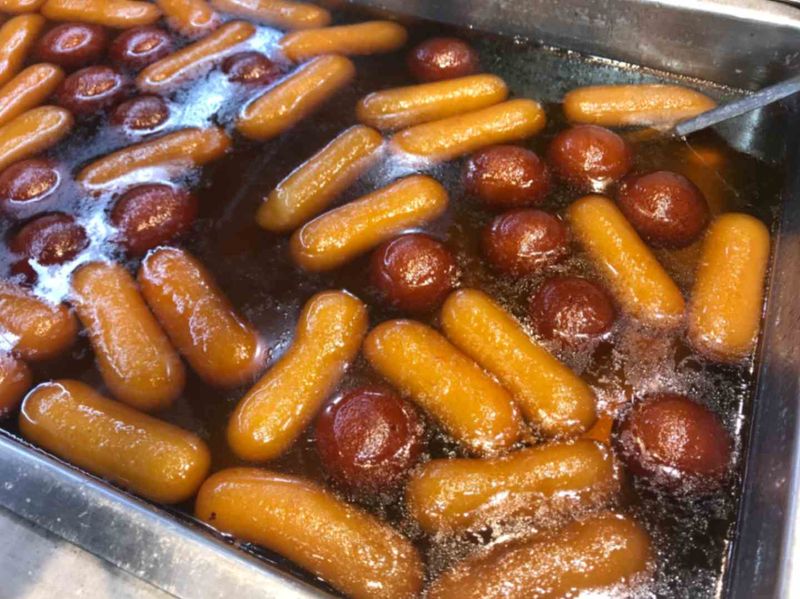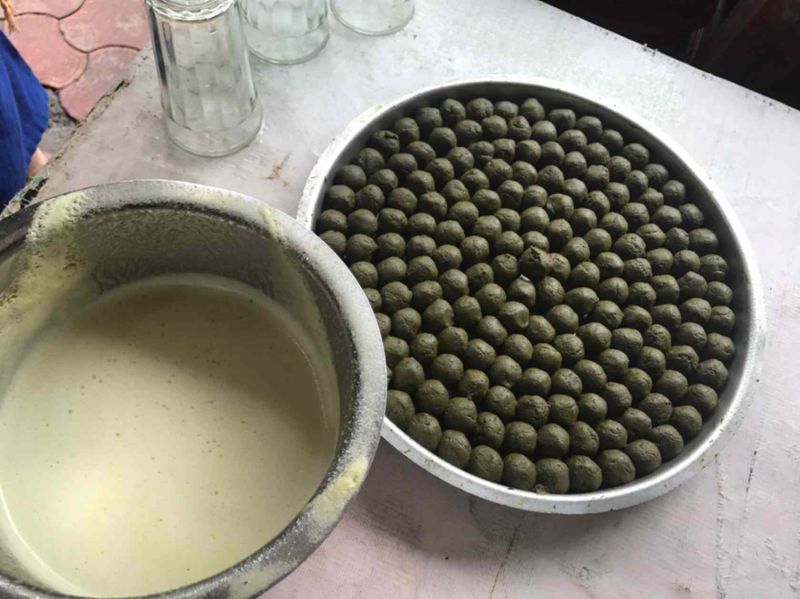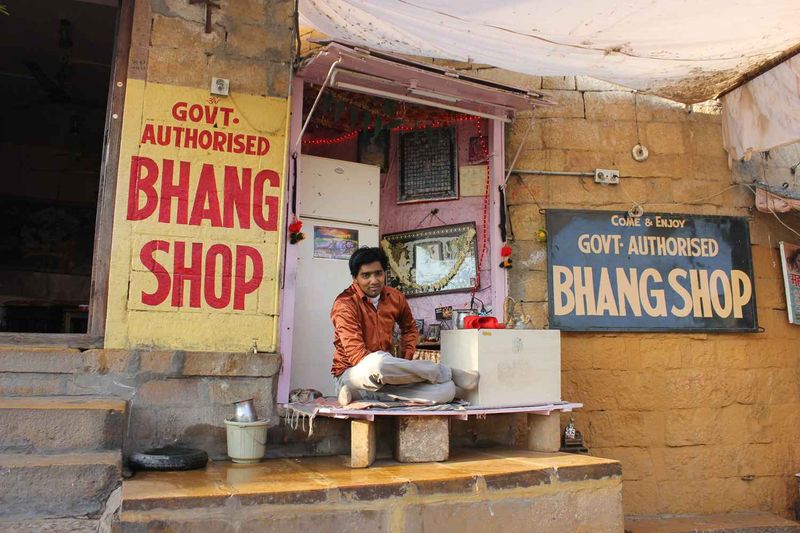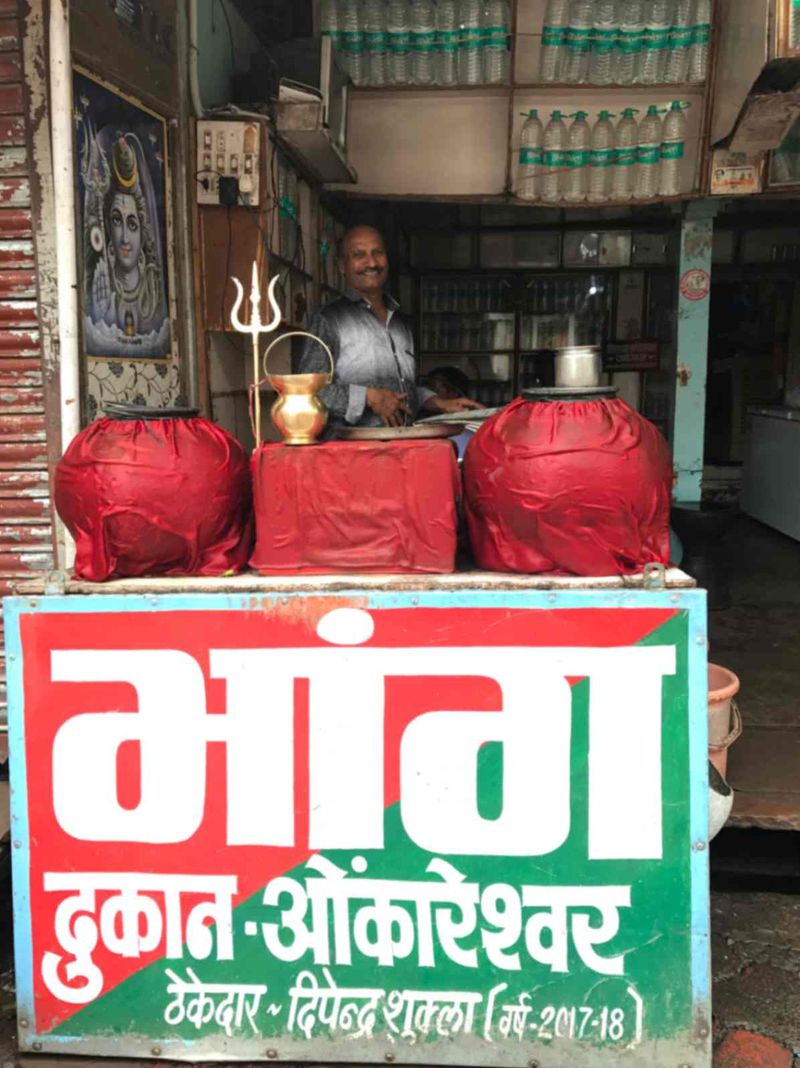We’ve quaffed bhang thandai during Holi, popped bhang golis during Maha Kumbh, munched on cannabis cookies in the Thar desert and had bhang lassi at Government authorised bhang shops from Allahabad (Prayagraj) to Varanasi, Pushkar to Jaisalmer and Ujjain to Omkareshwar.
Bhang is the oldest known cannabis edible, with Hindu texts dating back to 1000 BC recording the use of bhang by Shiva’s devotees during religious rituals. Associated with festivities such as Maha Shivaratri and Holi, bhang thandai is a cannabis and milk-based beverage that provides strength and vitality, soothes nerves and elevates your mood that borders on euphoria.

According to Hindu mythology, the Samudra Manthan (Churning of the Cosmic Ocean) yielded many precious objects, including the poison halahala. Since no one could bear its toxic fumes, Lord Shiva consumed it. Alarmed, Parvati grasped his neck to prevent him from swallowing it, which turned his throat blue, earning him the name ‘Neelkanth’. It is also believed that Parvati gave him cannabis as medicine to ease his discomfort. Which explains the association of the herb with Lord Shiva and the practice of pouring water, milk, honey or ghee on a Shivling ‘to cool him down’. From bhaang to thandai, all things cool and calming are preferred by him.
Before you wonder about the legality of it, the 1985 Narcotics Drugs and Psychotropic Substances (NDPS) Act bans charas/hash or cannabis resin and ganja or flowers. However, the seeds, stems and leaves of the same plant Cannabis Indica are exempt. Since bhang is made by grinding the leaves into a paste, it is legal in India. And so are bhang preparations. Here’s our Holi special – cannabis treats specially curated from our travels across India.

Bhang gulab jamun and kaju barfi
Bhagwan Das Prahlad Das & Sons, Prayagraj
Established in 1834, the 190-year-old sweet shop Bhagwan Das, Prahlad Das & Sons in Prayagraj’s busy Chowk area is known for its breakfast of puri-sabji and samosa, besides excellent imarti, jalebi and sweets made with pure desi ghee. Their motichoor laddus made with small boondis are simply exceptional. Every year, during Shivratri and Holi they also prepare limited batches of bhaang gulab jamuns on request. It’s so good, your mind will go balabjalam! They also make bhaang kaju katli. “The key is in extracting the essence of bhaang in the ghee. You can hardly discern any change in taste,” says fifth generation owner Ankit Gupta. Travel to Prayag for a bite of it, stay at Badi Kothi and take a holy dip at the Sangam to wash away your sins.
Where: 126/2, KP Kakkar Road, Zero Road, Prayagraj
Bhang kulfi
Ramesh Kulfi, Jamshedpur
After a quarrel at home, Ramesh Prasad came to Jamshedpur from Jasidih in 1966 without a penny in his pocket. He only knew how to make good samosas and kulfis. Opportunity struck when there was a need for a canteen near the Court. He promptly impressed the District Judge with 12 singadas and 12 kulfis and earned a space to open Ramesh Kulfi in 1972. Ramesh Prasad passed away few years ago, but his sons continue to serve Deoghar-style mutton atthe (curry), fish curry meals and their legendary kulfi. Every year during Holi they make limited batches of their special bhang kulfi. As creamy as the regular kulfi and equally delicious, the green version packs a punch, so consume with care. Like a beer ad once put it, ‘it’s like being hit at the back of the head with a wet sock, only better’.
Where: Ramesh Kulfi, Court Canteen, Near Jubilee Park

Bhang thandai
Pandit Raja ki Mashoor Thandai, Lucknow
Lucknow’s legendary thandai shop was started in 1936 by Ramadhar Shivadhar Tiwari and inaugurated by Jawaharlal Nehru. The shop gained fame as ‘Pandit Raja ki mashoor thandai’ after his son Vinod Kumar Tripathi or ‘Raja’. The thandai contains sugar, almonds, dry fruits, cardamom, pepper, saffron, fennel seeds, watermelon kernels, rose petals and poppy seeds. All the ingredients are typically ground into a paste by hand on a silauti (stone grinder); a recipe that’s remained unchanged for three generations. The bhang thandai, with cannabis extract added to the regular thandai is available all year round and served only on request.
Third-generation owner Ashish Tripathi is a major cannabis advocate and plans to start special sweets like bhang laddu and barfi. He insists that bhang has gained notoriety as a drug, but is actually a medication that induces hunger, clears bowels and calms the nerves… In Indian culture, intellectuals and elders have consumed it. The thandai shop used to host baithaks and chakallas (gossip sessions) where former PM Atal Bihari Vajpayee and his poet friends discussed literature and politics. Writer Vibhuti Varma and former UP CM Kalyan Singh frequented the shop too, which continues to attract professors, lawyers and writers. Must try: Thandai (INR 60 for small; INR 70 for big).
Where: Kasturba Market, Gole Darwaza Chowk Chauraha, Opp Santoshi Mata Mandir

Bhang lassi/cannabis cookies
Government Authorised Bhang Shop, Jaisalmer
Located at the base of Jaisalmer Fort since the early 1970s, the tiny shop was immortalised by Anthony Bourdain. Chander Prakash Vyas or Babu, better known as Doctor Bhang, represents the tech-savvy third generation. He has YouTube videos, an FB page and a killer spiel to hawk his potion to foreign tourists. “We have a light Baby Lassi for Japanese-Korean people because they have baby eyes, then Medium, Strong and Super Duper Sexy Strong – full power 24-hour, no toilet, no shower!” Besides bhang lassis in banana, chocolate and other flavours, they also have cannabis cookies and bhang chocolates. Dr Bhang took a long look at us and suggested, “Better you take Super Duper Sexy Strong!” A Dry Fruit lassi here is INR 300 and a plain lassi is INR 150.
Where: Khejer Para, Manak Chowk, Amar Sagar Pol
Bhang Lassi
Blue Lassi Shop, Varanasi
In the bylanes of Varanasi off Kachouri Gali en route to Manikarnika Ghat is a 90-year-old lassi shop that churns out a staggering 108 varieties of lassi. Started by Pannalal, it was known as Pannalal’s Lassi Shop until its blue interiors inspired some Korean tourists to rename it as ‘Blue Lassi Shop’ and the name stuck. Every visitor leaves a photo or a note and messages from fans are scrawled on every inch of the walls. The shop makes a mean bhang lassi that sets you back by INR 350 and about six to eight hours! Its inflationary pricing was spurred by a listing in Lonely Planet and Instagram fame. Grab a shanti spot by the ghats and watch the daily dance of life (and death) for hours. At Badal Thandai on Gowdolia Chowk, you can get bhang ki thandai, for as less as INR 60.
Where: Ck 12/1, Kunj Gali, Kachowri Gali, Near Rajbandhu

Sukhi bhang/bhang thandai
Bhang Ghota, Ujjain/Omkareshwar
In Ujjain, glug a bhang goli down with water or sip a bhang thandai at Shri Mahakal Bhang Ghota at Gopal Mandir Chowk – they also have sukhi bhang. Sree Mahakaleshwar Bhang Ghota on Mahakal Marg serves good bhang thandai, including a mango-flavoured one! The bhang golis are diluted in a milk and thandai concoction. You’ll find Bhang Dukan serving thandai in the lanes around Omkareshwar jyotirlinga also.
Where: Gopal Mandir Chowk, Ujjain

Bhang goli
Sarkari Theka Bhaang, Mathura
Mathura has its share of ‘bhang ki dukan’ that serve bhang goli and lassis, enriched with badam (almond), kesar (saffron), pista thandai and spices including cardamom, pepper and saunf (fennel seeds). Drop by at Sarkari Bhang Theka at Manoharpura and Holi Gate, run by Babbu Guru. A thandai here costs INR 40 and bhang costs INR 50.
Where: Manoharpura and Holi Gate, Mathura
Bhang Murg
Club Mahindra Binsar Valley, Uttarakhand
In the Kumaon region of Uttarakhand, it is fairly common to consume protein-packed cannabis seeds and leaves in local cooking. Club Mahindra Binsar Valley serves a unique bhang murg – chicken marinated with hemp seed paste. Coated in a greenish brown paste it looks a bit like pudina chicken, but tastes more herby and nutty. They also serve it as part of a traditional Kumaoni meal on a kansa platter with bhang ki jholi (kadhi), bhang ki chutney, bichhu booti ki chutney (stinging nettle), gahat ki dal (horsegram), arbi ke gutke (colocasia wedges), bhat ka jola (black soya bean), palak ka kaapa (smoked spinach gravy), jangora (unpolished red rice), madua ki roti (ragi or finger millet flatbread) and lapsi (flour porridge). Sorry to break the news, but no, you don’t get high. It is a healthy meal in the high hills.
Where: Almora-Takula-Bageshwar Road, Bhainsori Post, Almora District


_1711268064180_thumb_1200.jpeg?w=3840&q=75)